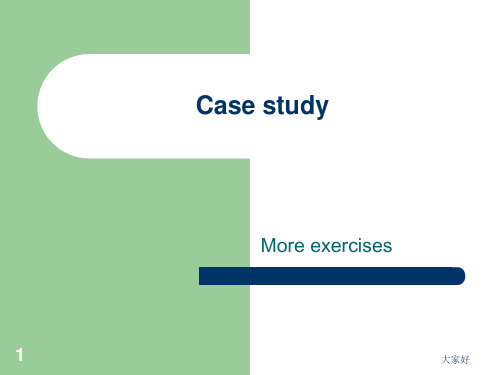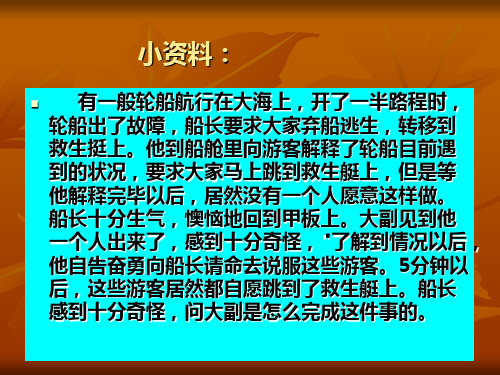跨文化交际案例分析ppt课件
合集下载
跨文化交际 ppt课件

美国人的会话风格
• 其主流语言风格被视为“体谅模式”,主要以 加州为主。
• 另一种语言风格为“参与模式”,以纽约为主 。
交际方式
• 东方人采取单向的保龄球方式。 • 西方人采取的是双向的乒乓球式。
非语言交际差异
非语言交际的定义
• 在交际过程中不是用口头或文字形式进行 信息传递的沟通方式即为非语言交际
• A lucky dog. • As faithful as a dog. 走狗 • Work as hard as a dog. 老黄牛 • 汉语:狗急跳墙,狗血喷头,狗眼看人低,
狗拿耗子多管闲事,狗嘴里吐不出象牙。狗 咬吕洞宾,不识好人心。
(美国)象征着死亡,祭奠亡灵和扫墓时 使用,相当于菊花。(主要用于复活节)
讨论: 鱼在英语中的含义?
• Fish in the air • 水中捞月 • A poor fish • 可怜虫 • A loose fish • 放荡不羁者 • A small fish
颜色词的文化差异,如红色、白色和黄色。 • 红色:happy, health,luck. 红对联、红包、红
3. What’s up? Can’t complain./Same as usual.
2. 东西方称呼语差异
• 东方人在称呼上更强调地位、辈份和身份。 • 西方人则更突出性别和婚姻。 • 东方人通常将姓氏放在名字的前面。 • 亚洲许多国家例如中国、韩国、越南,女
性婚后一般不随夫姓。
• 西方人大多习惯将名字放在姓氏之前,在 西方文化中,女人结婚后要随其丈夫的姓 氏。
• 这一部分需要大家课后去搜索:请找出尽 可能多的手势差异,如ok的手势语,竖起 大拇指的手势语等。
跨文化交际障碍
跨文化交际PPT演示课件

23
3. Space and Distance
3.1 Proxemics 3.2 Attitudes Toward Crowding
24
3.1 Proxemics
✓ Definition: the study of people’s perception and use of space.
✓ Four categories: intimate, personal, social, and public distance.
26
Categories of Distance (cont’d)
• Social Distance (1.3-3m) - colleagues, business partners, people at social gatherings
• Public Distance (beyond 3m) - speaking in public
- direct intrusion into others’ affairs • Shrugging shoulders
- indifferent, powerless, having no secret to conceal
19
Postures (cont’d)
• Follow one’s natural habits so often go unnoticed (subconscious in nature)
• May damage your image if you neglect your postures
20
2.4 Eye Contact
Direct eye contact • Chinese: avoid • North Americans: appreciate • The British: avoid
3. Space and Distance
3.1 Proxemics 3.2 Attitudes Toward Crowding
24
3.1 Proxemics
✓ Definition: the study of people’s perception and use of space.
✓ Four categories: intimate, personal, social, and public distance.
26
Categories of Distance (cont’d)
• Social Distance (1.3-3m) - colleagues, business partners, people at social gatherings
• Public Distance (beyond 3m) - speaking in public
- direct intrusion into others’ affairs • Shrugging shoulders
- indifferent, powerless, having no secret to conceal
19
Postures (cont’d)
• Follow one’s natural habits so often go unnoticed (subconscious in nature)
• May damage your image if you neglect your postures
20
2.4 Eye Contact
Direct eye contact • Chinese: avoid • North Americans: appreciate • The British: avoid
跨文化交际PPT演示文稿

4
第4页,共21页。
euphoria 过度兴奋的情绪
utopia 乌托邦(理想中最完美的地方) ecstasy 狂喜
fantasy 幻想,空想 pervade 蔓延,渗透
scoff at 嘲弄 national 国民
outburst 突发,爆发
expatriate 侨民
vertigo
眩晕
snapshot 快照,快拍
10
第10页,共21页。
11
第11页,共21页。
Four phases of cultural adaptation
Predeparture Stage Before entering the host cultrue, you feel
excited and face the future with optimism. Stage one: everything is beautiful
13
第13页,共21页。
Comprehension question
Question 1: What are the terms that can be applied to the
concept of “culture shock”?
Terms that can be applied to theconcept of―culture shock are culture stress, adaptation, transition shock, adjustment, socialization, and so on.
19
第19页,共21页。
Question 7:
What do you think of the author‟s suggestion of using the native language to compliment people inthe host culture?
跨文化国际交流案例分析PPT课件

also not explain to the hosts why they are sad and
what are their taboos.
Finally,The Inner Mongolia company didn't do a
w202e0/1l/l3 reserch on Indian culture. Moreover,
Second, Chinese hosts shoudn't prepare a
2020w/1/3hole
4
Explainations
Third, Chinese take them to local mental hospital
without obtainning Indian agreements, but Indian
company. From this case, we must learn from
that: respect cultural differences, avoid offend
some taboos, more communication with2源自20/1/39each
2020/1/3
10
Hindu, cattle has an great importance on their
heart and they regard it as God. Eating cattle is
their taboo. However, Inner Mogolia mainly eatting cattle and sheep.
2020/1/3
11
2020/1/3
7
Solutions
• For Indian Businessmen:When they come
what are their taboos.
Finally,The Inner Mongolia company didn't do a
w202e0/1l/l3 reserch on Indian culture. Moreover,
Second, Chinese hosts shoudn't prepare a
2020w/1/3hole
4
Explainations
Third, Chinese take them to local mental hospital
without obtainning Indian agreements, but Indian
company. From this case, we must learn from
that: respect cultural differences, avoid offend
some taboos, more communication with2源自20/1/39each
2020/1/3
10
Hindu, cattle has an great importance on their
heart and they regard it as God. Eating cattle is
their taboo. However, Inner Mogolia mainly eatting cattle and sheep.
2020/1/3
11
2020/1/3
7
Solutions
• For Indian Businessmen:When they come
跨文化交际案例分析PPT课件

•7
People from collectivistic culture view conflict as ultimately destructive for relationships, thinking that when members disagree they should adhere to the consensus of the group rather then engage in conflict. In culture like these, silence and avoidance may be used to manage conflict.
•2
“If you don’t acknowledge the problems”, he complained to one of the managers, “how do you expect to be able to solve them?” And then to further exasperate him, just today when a problem was finally brought to his attention, it was not mentioned until the end of the workday when there was no time left to solve it.
•8
Combine the theory with the
case
Thus, in this case, Koreans tried their best to take the peacemaking approach to de-escalate conflicts, so that harmony between members would be maintained as long as possible. However, Jim, from individualistic culture, considered it strange that his Korean colleagues would rather hide the problems to the last moment than solve the conflicts. In his view, suspending the conflicts wouldn’t release tensions and solidify the relationship but to potentially destruct the relationship.
People from collectivistic culture view conflict as ultimately destructive for relationships, thinking that when members disagree they should adhere to the consensus of the group rather then engage in conflict. In culture like these, silence and avoidance may be used to manage conflict.
•2
“If you don’t acknowledge the problems”, he complained to one of the managers, “how do you expect to be able to solve them?” And then to further exasperate him, just today when a problem was finally brought to his attention, it was not mentioned until the end of the workday when there was no time left to solve it.
•8
Combine the theory with the
case
Thus, in this case, Koreans tried their best to take the peacemaking approach to de-escalate conflicts, so that harmony between members would be maintained as long as possible. However, Jim, from individualistic culture, considered it strange that his Korean colleagues would rather hide the problems to the last moment than solve the conflicts. In his view, suspending the conflicts wouldn’t release tensions and solidify the relationship but to potentially destruct the relationship.
《跨文化交际》PPT课件

Elements of communication
• Context (location, time, light, temperature, seating arrangements)
• Participants (relationship, gender, culture) • Messages (meanings, symbols, encoding
• Samovar & Porter
Intercultural communication is communication between people whose cultural perceptions and symbol systems are distinct enough to alter the communication event.
Sender
encoding
noise
Channel (message)
deis an effective model of communication?
Interactive Model of Communication
decoding
message / channel
• Human beings draw close to one another by their common nature, but habits and customs keep them apart. ---- Confucian saying
• One man’s meat is another man’s poison. ---- English proverb
• Intercultural communication the penetration by a member of one culture into another culture (practical
跨文化交际ppt-

6.2烹饪方式的不同 7、总结
1、摘要
随着中国对外开放程度的逐渐深入,美国的社会文化越来 越多的映入我们的眼帘,其中餐饮由于地域特征、气候环境、 风俗习惯等因素的影响,会出现在原料、口味、烹调方法、 饮食习惯上的不同程度的差异,正是因为这样的差异,餐饮 产品具有了强烈的地域性。中美文化之间的差异造就了中美 饮食文化的差异,而这种差异来自中美不同的思维方式和处 世哲学,中国人注重“天人合一”,美国人注重“以人为 本”。
6.1、烹饪准则的不同
中美烹饪中处处显示的“随意”与
“规范”也体现了其饮食文化的不同。 美国人强调科学与营养,因此其烹制过 程体现了科学性和规范性。在烹制过 程中,美国人会完全依照菜谱,为了达到 准确无误,他们甚至会动用天平、液体 量杯、刻度锅等。因此美国人制作菜 肴往往比较机械,缺乏新意,毫无特色可 言。相反,中国烹饪却崇尚随意性。中 国烹饪中,不仅讲究各大菜系要有各自 的风味与特色,也还讲求各大菜系之间 交叉融合。同一道菜,由于地区、季节、 对象、作用、等级的不同,在操作上可 作不同的处理,从而其色、香、味变化 多端。如果离开了随意性,变化多端的 中国菜肴,就会失去其独特魅力。
Байду номын сангаас 1、摘要
2、前言
3、饮食观念的不同 3.1饮食的侧重点不同 3.2饮食的性质不同 4、饮食习惯的不同 4.1进餐的气氛不同 4.2肉食的饮用方式不同 4.3餐具使用的不同 4.4餐后习惯的不同 5、饮食结构的不同 5.1自然条件的不同 5.2生活方式的不同 6、饮食制作的不同 6.1烹饪准则的不同
3.1、饮食的侧重点不同
由于中美哲学思想的不同,美国人于饮食重科学。重科学 即讲究营养。故美国饮食以营养为最高标准。特别讲求食物 的营养成分,蛋白质,脂肪,碳水化合物,维生素及各类无 机元素是否搭配合理,热量供给是否恰到好处以及这些营养 成分是否能为进食者充分吸收。而中国更加关注菜肴的色、 香、味。中国的五味调和的烹饪术皆在追求美味,其加工过 程中的热油炸和长时间的文火攻,都会使菜肴的营养成分被 破坏。
1、摘要
随着中国对外开放程度的逐渐深入,美国的社会文化越来 越多的映入我们的眼帘,其中餐饮由于地域特征、气候环境、 风俗习惯等因素的影响,会出现在原料、口味、烹调方法、 饮食习惯上的不同程度的差异,正是因为这样的差异,餐饮 产品具有了强烈的地域性。中美文化之间的差异造就了中美 饮食文化的差异,而这种差异来自中美不同的思维方式和处 世哲学,中国人注重“天人合一”,美国人注重“以人为 本”。
6.1、烹饪准则的不同
中美烹饪中处处显示的“随意”与
“规范”也体现了其饮食文化的不同。 美国人强调科学与营养,因此其烹制过 程体现了科学性和规范性。在烹制过 程中,美国人会完全依照菜谱,为了达到 准确无误,他们甚至会动用天平、液体 量杯、刻度锅等。因此美国人制作菜 肴往往比较机械,缺乏新意,毫无特色可 言。相反,中国烹饪却崇尚随意性。中 国烹饪中,不仅讲究各大菜系要有各自 的风味与特色,也还讲求各大菜系之间 交叉融合。同一道菜,由于地区、季节、 对象、作用、等级的不同,在操作上可 作不同的处理,从而其色、香、味变化 多端。如果离开了随意性,变化多端的 中国菜肴,就会失去其独特魅力。
Байду номын сангаас 1、摘要
2、前言
3、饮食观念的不同 3.1饮食的侧重点不同 3.2饮食的性质不同 4、饮食习惯的不同 4.1进餐的气氛不同 4.2肉食的饮用方式不同 4.3餐具使用的不同 4.4餐后习惯的不同 5、饮食结构的不同 5.1自然条件的不同 5.2生活方式的不同 6、饮食制作的不同 6.1烹饪准则的不同
3.1、饮食的侧重点不同
由于中美哲学思想的不同,美国人于饮食重科学。重科学 即讲究营养。故美国饮食以营养为最高标准。特别讲求食物 的营养成分,蛋白质,脂肪,碳水化合物,维生素及各类无 机元素是否搭配合理,热量供给是否恰到好处以及这些营养 成分是否能为进食者充分吸收。而中国更加关注菜肴的色、 香、味。中国的五味调和的烹饪术皆在追求美味,其加工过 程中的热油炸和长时间的文火攻,都会使菜肴的营养成分被 破坏。
跨文化交际案例分析PPT课件

.
6
Cultural Analysis
High-context/ low-context culture Individualistic/ collectivistic culture Attitude towards bad news
.
7
Cultural analysis
In individualistic culture, they view conflict as fundamentally a good thing. Working through conflict can gain new information about members, defuse more serious conflict, and increase group cohesiveness. Individuals should be encouraged to think of creative, even farreaching solutions to conflicts. There is also value in direct confrontation, recognizing conflict and working through it in an open, productive way.
2
.
During his first week he was met with bows, polite smiles, and the continual denial of any significant problems. But Jim was enough of a realist to know that he had never heard of any manufacturing operation that didn’t have some problems. So after some research, he uncovered a number of problems that the local manager and staff were not acknowledging. None of the problems were particularly unusual or difficult to solve, but Jim was frustrated that no one would admit that any problems existed.
跨文化交际案例分析 PPT

Cultural Analysis
High-context/ low-context culture Individualistic/ collectivistic culture Attitude towards bad news
Cultural analysis
In individualistic culture, they view conflict as fundamentally a good thing. Working through conflict can gain new information about members, defuse more serious conflict, and increase group cohesiveness. Individuals should be encouraged to think of creative, even farreaching solutions to conflicts. There is also value in direct confrontation, recognizing conflict and working through it in an open, productive way.
3
大家好
“If you don’t acknowledge the problems”, he complained to one of the managers, “how do you expect to be able to solve them?” And then to further exasperate him, just today when a problem was finally brought to his attention, it was not mentioned until the end of the workday when there was no time left to solve it.
跨文化交际案例分析[优质ppt]
![跨文化交际案例分析[优质ppt]](https://img.taocdn.com/s3/m/65a044773b3567ec112d8a13.png)
Case study
• Typical sections:
– case summary – Cultural reasons – alternatives – conclusion
Suggested answer
Case summary
Jim was sent to Korean plant to help people there with some new managerial procedures, though Jim was welcomed with great hospitality, only to find that his Korean colleagues tried to avoid acknowledging any significant problems, let alone solving them. Jim couldn’t understand the way that Korean solved the problem. To his exasperation, a problem was mentioned when there was no time left to solve it.
During his first week he was met with bows, polite smiles, and the continual denial of any significant problems. But Jim was enough of a realist to know that he had never heard of any manufacturing operation that didn’t have some problems. So after some research, he uncovered a number of problems that the local manager and staff were not acknowledging. None of the problems were particularly unusual or difficult to solve, but Jim was frustrated that no one would admit that any problems existed.
第五章跨文化沟通与交流PPT课件

28
( 1)目光接触 ①倾听时的眼神行为与发言时的眼神行为。很多研究己经
表明,在发言和倾听的过程中,眼神行为可能是不一样的。 即使人们生活在同一地理区域之中,这种差异在文化内部 也会产生。
欧裔美国人在发言的时候,通常不会保持直接的、不变 的目光接触,他们宁愿更趋向于在说话的时候,把脸扭转 过去,仅仅偶尔回头扫一眼,以便确认与听者的眼神接触; 但是,当他们在倾听的时候,通常都会保持直接的、不变 的目光接触;也就是说。欧裔美国人通常受到的教育是听 众一定要专注地看着发言者。当其他人不能维持"正确的" 目光接触的时候,大部分欧裔美国人都会感到恼火。 非裔美国人文化 研究还表明,非裔美国人在倾听、发 言的时候所表现出来的眼神行为和欧裔美国人的表现是不 同的。例如,非裔美国人在说话时眼神通常是专注于听者 的;然而,在倾听他人时,非裔美国人会低头或转过头去。
1
标题添加
点击此处输入相 关文本内容
前言
点击此处输入 相关文本内容
标题添加
点击此处输入相 关文本内容
点击此处输入 相关文本内容
2
大副对船长说:"我对他们几个不同国家 的人说了不同的话:
我对英国人说,这是一件很有绅士风度的 事;
我对德国人说,这是命令; 我对法国人说,这是一件很浪漫的事; 我对美国人说,你是被保了险的。"
27
2、非□头语言沟通的跨文化差异
在进行跨文化沟通的时候,成功的关 键就在于是否理解非言语沟通。非言语沟 通是指不通过语言而传达出意思的沟通。
据研究者估计,在全部沟通中,有85都 是非言语沟通;而在各种不同的文化中,这 种沟通类型的重要性也是极不相同的。
非言语沟通包括目光接触、面部表情、手 势、身体空间的利用以及沉默。
( 1)目光接触 ①倾听时的眼神行为与发言时的眼神行为。很多研究己经
表明,在发言和倾听的过程中,眼神行为可能是不一样的。 即使人们生活在同一地理区域之中,这种差异在文化内部 也会产生。
欧裔美国人在发言的时候,通常不会保持直接的、不变 的目光接触,他们宁愿更趋向于在说话的时候,把脸扭转 过去,仅仅偶尔回头扫一眼,以便确认与听者的眼神接触; 但是,当他们在倾听的时候,通常都会保持直接的、不变 的目光接触;也就是说。欧裔美国人通常受到的教育是听 众一定要专注地看着发言者。当其他人不能维持"正确的" 目光接触的时候,大部分欧裔美国人都会感到恼火。 非裔美国人文化 研究还表明,非裔美国人在倾听、发 言的时候所表现出来的眼神行为和欧裔美国人的表现是不 同的。例如,非裔美国人在说话时眼神通常是专注于听者 的;然而,在倾听他人时,非裔美国人会低头或转过头去。
1
标题添加
点击此处输入相 关文本内容
前言
点击此处输入 相关文本内容
标题添加
点击此处输入相 关文本内容
点击此处输入 相关文本内容
2
大副对船长说:"我对他们几个不同国家 的人说了不同的话:
我对英国人说,这是一件很有绅士风度的 事;
我对德国人说,这是命令; 我对法国人说,这是一件很浪漫的事; 我对美国人说,你是被保了险的。"
27
2、非□头语言沟通的跨文化差异
在进行跨文化沟通的时候,成功的关 键就在于是否理解非言语沟通。非言语沟 通是指不通过语言而传达出意思的沟通。
据研究者估计,在全部沟通中,有85都 是非言语沟通;而在各种不同的文化中,这 种沟通类型的重要性也是极不相同的。
非言语沟通包括目光接触、面部表情、手 势、身体空间的利用以及沉默。
- 1、下载文档前请自行甄别文档内容的完整性,平台不提供额外的编辑、内容补充、找答案等附加服务。
- 2、"仅部分预览"的文档,不可在线预览部分如存在完整性等问题,可反馈申请退款(可完整预览的文档不适用该条件!)。
- 3、如文档侵犯您的权益,请联系客服反馈,我们会尽快为您处理(人工客服工作时间:9:00-18:30)。
2
During his first week he was met with bows, polite smiles, and the continual denial of any significant problems. But Jim was enough of a realist to know that he had never heard of any manufacturing operation that didn’t have some problems. So after some research, he uncovered a number of problems that the local manager and staff were not acknowledging. None of the problems were particularly unusual or difficult to solve, but Jim was frustrated that no one would admit that any problems existed.
Cultural Analysis
High-context/ low-context culture Individualistic/ collectivistic culture Attitude towards bad news
7
Cultural analysis
In individualistic culture, they view conflict as fundamentally a good thing. Working through conflict can gain new information about members, defuse more serious conflict, and increase group cohesiveness. Individuals should be encouraged to think of creative, even far-reaching solutions to conflicts. There is also value in direct confrontation, g conflict and working through it in an open, productive 8
People from collectivistic culture view conflict as ultimately destructive for relationships, thinking that when members disagree they should adhere to the consensus of the group rather then engage in conflict. In culture like these, silence and avoidance may be used to manage conflict.
4
Case study
• Typical sections:
– case summary – Cultural reasons – alternatives – conclusion
5
Suggested answer
Case summary
Jim was sent to Korean plant to help people there with some new managerial procedures, though Jim was welcomed with great hospitality, only to find that his Korean colleagues tried to avoid acknowledging any significant problems, let alone solving them. Jim couldn’t understand the way that Korean solved the problem. To his exasperation, a problem was mentioned when there was 6
3
“If you don’t acknowledge the problems”, he complained to one of the managers, “how do you expect to be able to solve them?” And then to further exasperate him, just today when a problem was finally brought to his attention, it was not mentioned until the end of the workday when there was no time left to solve it.
Case study
More exercises
1
Case 1
Jim Ellis, vice president of a North Carolina knitwear manufacturer, was sent by his company to observe firsthand how operations were proceeding in their Korean plant and to help institute some new managerial procedures. Before any changes could be made, however, Jim wanted to learn as much as possible about the problems that existed at the plant.
During his first week he was met with bows, polite smiles, and the continual denial of any significant problems. But Jim was enough of a realist to know that he had never heard of any manufacturing operation that didn’t have some problems. So after some research, he uncovered a number of problems that the local manager and staff were not acknowledging. None of the problems were particularly unusual or difficult to solve, but Jim was frustrated that no one would admit that any problems existed.
Cultural Analysis
High-context/ low-context culture Individualistic/ collectivistic culture Attitude towards bad news
7
Cultural analysis
In individualistic culture, they view conflict as fundamentally a good thing. Working through conflict can gain new information about members, defuse more serious conflict, and increase group cohesiveness. Individuals should be encouraged to think of creative, even far-reaching solutions to conflicts. There is also value in direct confrontation, g conflict and working through it in an open, productive 8
People from collectivistic culture view conflict as ultimately destructive for relationships, thinking that when members disagree they should adhere to the consensus of the group rather then engage in conflict. In culture like these, silence and avoidance may be used to manage conflict.
4
Case study
• Typical sections:
– case summary – Cultural reasons – alternatives – conclusion
5
Suggested answer
Case summary
Jim was sent to Korean plant to help people there with some new managerial procedures, though Jim was welcomed with great hospitality, only to find that his Korean colleagues tried to avoid acknowledging any significant problems, let alone solving them. Jim couldn’t understand the way that Korean solved the problem. To his exasperation, a problem was mentioned when there was 6
3
“If you don’t acknowledge the problems”, he complained to one of the managers, “how do you expect to be able to solve them?” And then to further exasperate him, just today when a problem was finally brought to his attention, it was not mentioned until the end of the workday when there was no time left to solve it.
Case study
More exercises
1
Case 1
Jim Ellis, vice president of a North Carolina knitwear manufacturer, was sent by his company to observe firsthand how operations were proceeding in their Korean plant and to help institute some new managerial procedures. Before any changes could be made, however, Jim wanted to learn as much as possible about the problems that existed at the plant.
